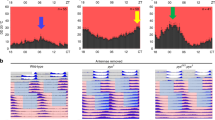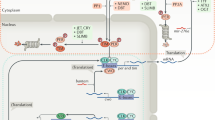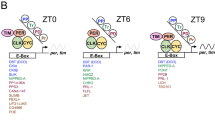Abstract
Many biochemical, physiological and behavioural processes in organisms ranging from microorganisms to vertebrates exhibit circadian rhythms1. In Drosophila, the gene period (per) is required for the circadian rhythms of locomotor activity and eclosion behaviour2. Oscillation in the levels of per mRNA and Period (dPer) protein in the fly brain is thought to be responsible for the rhythmicity3,4. However, no per homologues in animals other than insects have been identified. Here we identify the human and mouse genes (hPER and mPer, respectively) encoding PAS-domain (PAS, a dimerization domain present in Per, Amt and Sim)-containing polypeptides that are highly homologous to dPer. Besides this structural resemblance, mPer shows autonomous circadian oscillation in its expression in the suprachiasmatic nucleus, which is the primary circadian pacemaker in the mammalian brain5,6. Clock, a mammalian clock gene encoding a PAS-containing polypeptide7,8, has now been cloned: it is likely that the Per homologues dimerize with other molecule(s) such as Clock through PAS–PAS interaction in the circadian clock system.
This is a preview of subscription content, access via your institution
Access options
Subscribe to this journal
Receive 51 print issues and online access
$199.00 per year
only $3.90 per issue
Buy this article
- Purchase on Springer Link
- Instant access to full article PDF
Prices may be subject to local taxes which are calculated during checkout




Similar content being viewed by others
References
Edmunds, L. N. J. Cellular and Molecular Basis of Biological Clocks (Springer, New York, (1988)).
Konopka, R. J. & Benzer, S. Clock mutants of Drosophila melanogaster. Proc. Natl Acad. Sci. USA 68, 2112–2116 (1971).
Hardin, P. E., Hall, J. C. & Rosbash, M. Feedback of the Drosophila period gene product on circadian cycling of its messenger RNA levels. Nature 343, 536–540 (1990).
Zerr, D. M., Hall, J. C., Rosbash, M. & Siwicki, K. K. Circadian fluctuations of period protein immunoreactivity in the NS and the visual system of Drosophila. J. Neurosci. 10, 2749–2762 (1990).
Moore, R. Y. & Eichler, V. B. Loss of a circadian adrenal corticosterone rhythm following suprachiasmatic lesions in the rat. Brain Res. 42, 201–216 (1972).
Stephen, F. K. & Zucker, I. Circadian rhythms in drinking behavior and locomotor activity of rats are eliminated by hypothalamic lesions. Proc. Natl Acad. Sci. USA 69, 1583–1586 (1972).
King, D. P. et al. Positional cloning of the mouse circadian Clock gene. Cell 89, 641–653 (1997).
Antoch, M. P. et al. Functional identification of the mouse circadian Clock gene by transgenic BAC rescue. Cell 89, 655–667 (1997).
Baylies, M. K., Bargiello, T. A., Jackson, F. R. & Young, M. W. Changes in abundance of structure of the per gene product can alter periodicity of the Drosophila clock. Nature 326, 390–392 (1987).
Saez, L. & Young, M. W. Regulation of nuclear entry of the Drosophila clock proteins Period and Timeless. Neuron 17, 911–920 (1996).
Citri, Y. et al. Afamily of unusually spliced biologically active transcripts encoded by a Drosophila clock gene. Nature 326, 42–47 (1987).
Vosshall, L. B., Price, J. L., Sehgal, A., Saez, L. & Young, M. W. Block in nuclear localization of period protein by a second clock mutation, timeless. Science 263, 1606–1609 (1996).
Huang, Z. J., Curtin, K. D. & Rosbash, M. PER protein interactions and temperature compensation of a circadian clock in Drosophila. Science 267, 1169–1172 (1995).
Wheeler, D. A. et al. Molecular transfer of a species-specific behavior from Drosophila simulans and Drosophila melanogaster. Science 251, 1082–1085 (1991).
Colot, H. V., Hall, J. C. & Rosbash, M. Interspecific comparison of the period gene of Drosophila reveals large blocks of non-conserved coding DNA. EMBO J. 7, 3929–3937 (1988).
Reppert, S. M., Tsai, T., Roca, A. L. & Sauman, I. Cloning of a structural and functional homolog of the circadian clock gene period from the giant silkmoth Antheraea pernyi. Neuron 13, 1167–1176 (1994).
Liu, X., Lorenz, L., Yu, Q., Hall, J. C. & Rosbash, M. Spatial and temporal expression of the period gene in Drosophila melanogaster. Genes Dev. 2, 228–238 (1988).
Saez, L. & Young, M. W. In situ localization of the per clock protein during development of Drosophila melanogaster. Mol. Cell. Biol. 8, 5378–5385 (1988).
Inouye, S.-T. & Kawamura, H. Persistence of circadian rhythmicity in a hypothalamic ‘island’ containing the suprachiasmatic nucleus. Proc. Natl Acad. Sci. USA 76, 5962–5966 (1979).
Schwarts, W. J. & Gainer, H. Suprachiasmatic nucleus: use of 14C-labeled deoxyglucose uptake as a functional marker. Science 197, 1089–1092 (1977).
Gillette, M. U. & Reppert, S. M. The hypothalamic suprachiasmatic nuclei: circadian patterns of vasopressin secretion and neuronal activity in vitro. Brain Res. Bull. 19, 135–139 (1987).
Vitaterna, M. H. et al. Mutagenesis and mapping of a mouse gene, Clock, essential for circadian behavior. Science 264, 719–725 (1994).
Ralph, M. R. & Menaker, M. Amutation of the circadian system in golden hamsters. Science 241, 1225–1227 (1988).
Ito, T., Hohjoh, H. & Sakaki, Y. Pulse-field polyacrylamide gel electrophoresis: basic phenomena and applications. Electrophoresis 14, 278–282 (1993).
Sambrook, J., Fritsch, E. F. & Maniatis, T. Molecular Cloning (Cold Spring Harbor Laboratory Press, NY, (1989)).
Church, G. M. & Gilbert, W. Genomic sequencing. Proc. Natl Acad. Sci. USA 81, 1991–1995 (1984).
Ban, Y., Shigeyoshi, Y. & Okamura, H. Development of circadian VIP rhythm in the rat suprachiasmatic nucleus. J. Neurosci. 17, 3920–3931 (1997).
Acknowledgements
We thank J. Inazawa and M. Hirai for mapping hPER and mPer, respectively; Y.Maebayashi for technical assistance, S.-T. Inouye and M. Hattori for discussion; and D. Yamamoto, R.Ueda, T. Ito and K. Ui-Tei for comments and discussions on the manuscript. This work was partly supported by research grants from the Japanese Ministry of Education, Science, Sports and Culture, and the Japanese Ministry of Health and Welfare.
Author information
Authors and Affiliations
Corresponding author
Rights and permissions
About this article
Cite this article
Tei, H., Okamura, H., Shigeyoshi, Y. et al. Circadian oscillation of a mammalian homologue of the Drosophila period gene. Nature 389, 512–516 (1997). https://doi.org/10.1038/39086
Received:
Accepted:
Issue Date:
DOI: https://doi.org/10.1038/39086
This article is cited by
-
Cloning, tissue distribution, mRNA expression and functional analysis of circadian clock gene per2 from the high-latitude Amur minnow (Phoxinus lagowskii)
Aquaculture International (2023)
-
Intertwining roles of circadian and metabolic regulation of the innate immune response
Seminars in Immunopathology (2022)
-
Diurnal expression of circadian clock genes period 1 and period 3 in Pelteobagrus vachellii
Journal of Oceanology and Limnology (2021)
Comments
By submitting a comment you agree to abide by our Terms and Community Guidelines. If you find something abusive or that does not comply with our terms or guidelines please flag it as inappropriate.



